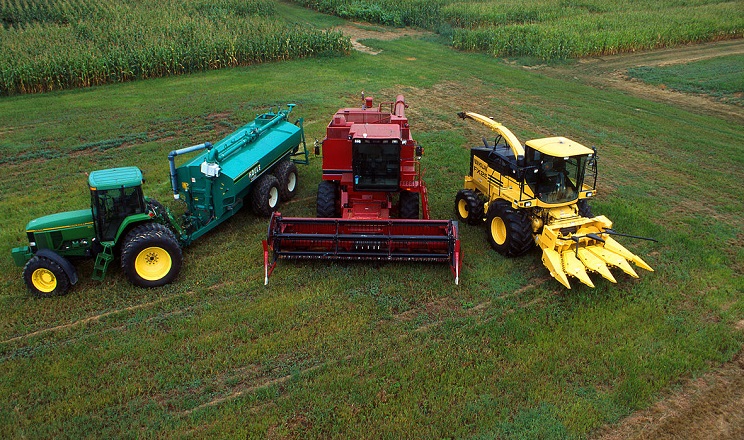
Since the beginning of Russia’s full-scale invasion, business has gone through various stages—from transformation to stabilization, and some businesses have already returned to conditionally “pre-war” indicators.
In effect, business has passed through three stages—a downturn (2022), adaptation (2023–2024), and the beginning of recovery (2025), which can be seen as a model of business response to a crisis with a fairly rapid recovery—within three years. Whether this is a testament to the overall resilience of the agricultural sector or the result of specific adaptation mechanisms is a question that requires further discussion. At the same time, it is worth assessing how the structure of agricultural machinery procurement has changed and what factors are shaping farmers’ choices today.
The agricultural machinery market, including self-propelled equipment, was no exception to this trend: minimal sales and a slump were recorded in 2022, followed by adaptation to new realities. Now, by the end of the first quarter of 2025, it is becoming clear how major foreign brands of self-propelled agricultural machinery have navigated these years, what the current figures are, and how indicators have changed across regions and in farmer preferences.
In the self-propelled machinery group, we are analyzing tractors, combines, and self-propelled sprayers from major foreign brands, excluding manufacturers from China, Japan, and other Asian countries. We are looking at the segment from 80 hp upwards. The focus on major foreign brands is due to complicated access to state registries and data. However, the market situation may be broader—for example, small agricultural enterprises and farmers more often turn to affordable alternatives, particularly machinery from Asia, due to limited resources. Meanwhile, sanctions on OJSC “MTZ” (Minsk Tractor Works) could have affected the presence of their equipment, although the exact scale and its impact on overall market dynamics require clarification.
The figures for 2024 indicate a return to the levels of 2019-2020 and an exit from the market slump of 2022-2023. It’s also important to remember that 2021 was a record year for sales, thanks to a combination of favorable factors (high yields, profitable prices).
Last year’s figures provide some cautious optimism—a 40.5% increase in sales compared to 2023, and a 24% increase against 2022, a year when a significant number of agribusinesses suffered or ceased operations (recalling the map of Russian military presence in Ukraine in 2022), and farmers’ (as the main clients of machinery sellers) access to finance and markets was limited.
The first two months of this year also inspire cautiously positive forecasts. From January to February 2025, sales by key major tractor manufacturers reached 313 units, exceeding all figures for the same period since 2017. Admittedly, this is a strong start.
Regarding the regionalization of sales, it cannot be said that there has been a significant shift in sales to western Ukraine; for the most part, the main sales occur in central Ukraine. For obvious reasons, tractor purchases have significantly dropped in the regions bordering Russia and in areas with active hostilities.
(Image Caption) Although 2021 data was initially used, its structure and regional distribution are almost identical to 2020, the year with which we compared overall sales above.
If we look at the sales structure of major foreign brands by power, sales in the 401-500 hp segment have grown 7-fold from 2020 to 2024, while the 301-400 hp segment has been in decline since 2015.
However, if we look at the first two months of 2025 and compare them with the same periods in previous years, the situation with the 301-400 hp and 401-500 hp segments has changed. Of the nearly 300 tractors sold, 59 units were in the 301-400 hp segment (the highest figure since 2017), while the 401-500 hp segment saw 25% fewer sales than the previous year (23 units in the first two months of 2025, compared to 31 units in the first two months of 2024).
It is too early to make any forecasts, but on one hand, the seven-fold increase in sales in the 401–500 hp segment from 2020 to 2024 looks like more than a random spike—perhaps it reflects the consolidation of farms between 2016 and 2020, when holding structures required powerful machinery to cultivate large areas, save resources, and optimize labor. On the other hand, the 25% decline in the first months of 2025 is quite atypical, as the previous growth had been maintained even during Russia’s full-scale invasion. Whether this is a temporary fluctuation or a change in trend remains to be seen from further data.
As for the 301-400 hp category, we observed a long-term decline since 2015, indicating a loss of popularity. However, the sudden revival (59 units) may point to activity among medium-sized agricultural businesses that are willing to choose expensive machinery from major brands, or it could be a temporary phenomenon related to the replacement of outdated machines.
Currently, it appears that the tractor market has stabilized but has not yet peaked. We compared the data mostly with the “subdued” year of 2020, not the “peak” year of 2021 when farmers were buying machinery due to sufficient cash reserves. Today’s situation suggests that farmers are replacing their worn-out fleet and gradually restoring their capacity. Furthermore, the high sales figures for January–February 2025 and the recovery from the 2022–2023 slump add to the cautious optimism. However, it is necessary to continue monitoring the high-power machinery segments to understand whether this is a temporary/one-off event or a “realignment” of the power market. By mid-year, we will see how farmers’ preferences change and whether this will affect combines and sprayers.
Specially for AgroPortal.ua
